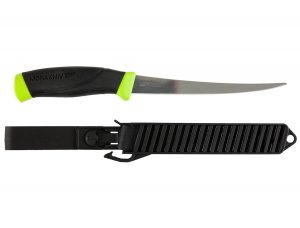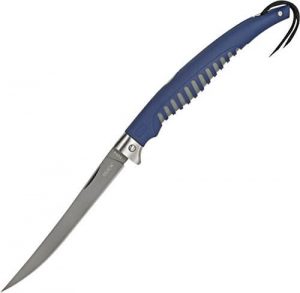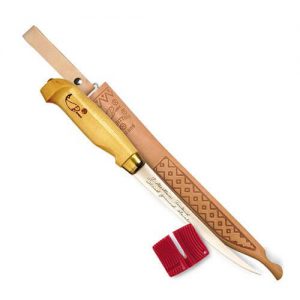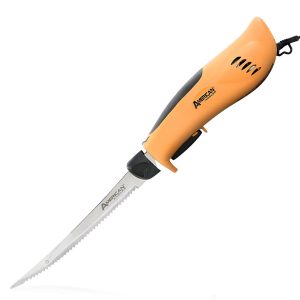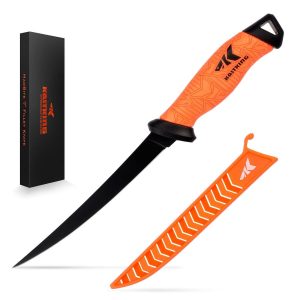Whether you enjoy filleting your own catch or even a fish that you have caught in the grocery store, having the right fish fillet knife can help ensure that the fish you serve up looks tasty and well-presented.
Because it can be difficult to find the right fillet knife, we have aimed to help you in your search by looking at some of the most popular manual and electric fillet knives across the size range and what it is that these have that can make your filleting easier. We hope that this detailed review will help you choose the best fish fillet knife for ensuring that your catch is well received at the dinner table.Quick Comparison: Top 10 Best Fish Fillet Knife
[table id=36 /]
1. Rapala Heavy Duty Electric Fillet Knife
With three times the power and twice the reciprocating style blade speed of a standard electric fillet knife (EFK), the Rapala heavy duty EFK has a 7½" blade which can be cleaned in the dishwasher. Like any EFK, it may take you some time to refine your filleting technique when using this knife and you will need occasional breaks to give the mechanism time to cool down.
The 110 volt Rapala has a comfort grip and comes with an 8ft power cord. There is also a one-year warranty on the product.Pros
Cons
2. Morakniv Fishing Comfort Fillet Knife
The 6.1" Morakniv fillet knife has a Sandvik 12C27 stainless steel blade known for its hardness, toughness, razor sharpness and rust resistance. This Swedish-made knife comes with a limited lifetime warranty. It has a high friction handle that is designed to perfect grip while filleting.
This knife comes with an easy clean plastic sheath and two interchangeable belt clips. Some users may find the sheath light duty and that the clips are less than sturdy when carrying it around on their belt.
Pros
Cons
3. Kershaw Clearwater 7" Fillet Knife
Made from Japanese 420J2 stainless steel, the Kershaw Clearwater 7" fillet knife is corrosion-resistant. Its handle is a well-balanced, non-slip grip co-polymer soft textured rubber. It also has neon accents on the handle – making it easier and safer to find in lower light.
You may find that it will need some extra sharpening on arrival and further careful sharpening is necessary to ensure that a sharp edge stays on this knife, it does however come with a limited lifetime warranty. There is also an ABS sheath with a belt loop, although the loop may be a little brittle for any heavy handling.Pros
Cons
4. Buck 0220BLS Knives Silver Creek Folding Fillet Fishing Knife
The Silver Creek folding fillet knife from Buck Knives offers a 6½" titanium coated 420J2 stainless steel blade. As this is a less flexible blade than similar products, you may not find it ideal for all your fileting needs. It may need some extra cleaning care before folding the knife to minimize the risk of corrosion on the locking mechanism.
As the locking mechanism ages, you may also need to take extra care to ensure that the knife is fully locked before putting away. With a grooved anti-slip grip handle for greater friction when wet and an easy folding mechanism, there is also a lifetime warranty on this knife.
Pros
Cons
5. Rapala NK03039-BRK Fish N Fillet
Made of European stainless steel, the 7½" blade on the Rapala Fish ‘n Fillet knife is progressively tapered, and its full tang blade keeps an ultra-sharp edge. Although very suitable for a range of filleting requirements, its length may limit its use with some larger fish.
This knife has a traditional reinforced birch handle, which may not be suitable for any extensive kitchen use due to the risk of it warping or cracking with constant washing. It also comes with a single stage sharpener as well as a tooled genuine leather Laplander sheath.Pros
Cons
6. Rapala Fish n Fillet Superflex Knife
The 4" Rapala Superflex knife has a hand ground extra thin stainless steel blade for greater flexibility. As this is a smaller 4” blade there will be a limit on what size fish you can fillet, and the handle may be a little small for larger hands.
The Superflex comes with a tooled leather sheath and its blade has a PTFE non-stick coating to allow fillets to easily fall away.Pros
Cons
7. American Angler PRO Electric Fillet Knife
Having a PRO Series motor for twice as much torque as similar heavier duty EFKs, the American Angler PRO also offers a longer lifespan than other EFKs. It has flexible hollow ground blades to improve its maneuvering ability and precision.
With a two-year limited warranty, this knife has an advanced airflow which keeps the handset cool even after using continuously, although some users may find that they may still need to take a break from filleting at times to allow the handle to cool before continuing.
As this is heavier than a traditional filleting knife, it may also take some time to become comfortable with the extra weight when using. Operating at 110 volts, with an 8ft polarized power cord, it is compatible with all American Angler replacement blades allowing you the choice of the most suitable blade for your catch.
Pros
Cons
8. KastKing Fillet Knife
The 7" KastKing curved fillet knife is German G4116 stainless steel with a black finish. It also has an easy clean polymer non-slip orange handle. Although it comes pre-sharpened, some users may wish to re-sharpen before first use and it will need regular sharpening after use as it is a stainless steel blade.
The KastKing comes with a durable and lightweight matching orange sheath which has drain holes and locks the knife handle in for safety when not in use.Pros
Cons
9. Shun DM0743 Classic Gokujo Boning and Fillet
The Shun 6" Gokujo knife is a stainless steel blade precision forged in Japan by the KAI blade manufacturer. It is VG-10 stainless steel with 16 layers of high carbon stainless steel on each side. This gives a 33 layered Damascus look and the associated microscopic air pockets to reduce friction buy without the rusting typically associated with Damascus steel.
Its contoured shape is for safe and efficient cutting away from bones, joints and tendons, although some handlers may find initial use slow if used to a straight filleting blade. Its handle is pakkawood with a steel end-cap. Although suitable for cleaning in the dishwasher, the manufacturer recommends hand washing. There is a limited lifetime warranty available on this knife.Pros
Cons
10. Elk Ridge ER-028 Fillet Knife
The Elk Ridge fillet knife has a total length of 12⅛" and its 6⅞" blade is 440 stainless steel. Its handle is a laminate wood design complete with a hole for inserting a clip or lanyard. The handle may be uncomfortable for some. A full tang blade, it also comes with a black nylon sheath and safety strap. Some users may find that this knife does need a sharpen before first use and more regular sharpening than similar models as it is a softer stainless steel.
Pros
Cons
Things to Consider Before Buying the Product
The Traditional or The Electric Fillet Knife (EFK)
A traditional or manual fillet knife makes precise cuts and offers the opportunity to obtain the most meat from a variety of fish.
An EFK is typically bigger and heavier than a traditional knife and users often need some practice before they can fillet efficiently with it. Corded EFKs also rely on a suitable power source and extra care needs taking to ensure the power cord is always safely away from the cutting area. EFKs can be especially useful when a large amount of filleting is necessary as they are often faster than the traditional knife.
Choosing a Fish Fillet Knife
The blade material, its flexibility, the knife size, handle and type of sheath are some of the main things to consider before buying a new fish fillet knife. Here we look at some these in a little more detail:
Blade material
Stainless steel is the main metal used in the manufacture of fillet knives as it offers less chance of corrosion, rust or tarnish; especially when working on or near the water. A full tang blade means that the blade metal runs the full length of the handle. This metal, or tang is usually visible at the very back end of the handle and sometimes at the top and bottom of the handle if two handle parts fasten around it.
Damascus steel was a method originally used in making swords in the Middle East. This original method was lost in around the 16th century but ‘Damascus knives’ appeared at a Guild Show in 1973 and since then, pattern welded steel blades have been known as Damascus. These blades are usually a mix of alloys which create a pattern and the performance of the blade alters by adjusting the alloy and its process of heat treatment. Damascus can also create a micro-serrated surface that helps when slicing.
Flexibility
Flexibility is a crucial factor when choosing a filleting knife. Like many choices, its flexibility can be down to personal preference, as well what types of fish we are using it for. Blade flexibility tends to be most critical when skinning or trimming around fins or bones.
Size of blade
A shorter blade is usually better for smaller species such as crappies and yellow perch, a 6" to 8" blade would be fine for trout and other similar sized fish, while a blade that is 9" or 10" upwards is usually better for large salmon and similar.
Some states have different laws around the maximum length of fillet knife you can carry and how you can carry, so before any purchase, it is always worth checking out any restrictions for where you are intending to use it.
Handle
The handle should allow you to keep a good grip on the knife while still being comfortable to hold even if covered in fish slime, blood or water.
Although wood is a popular and traditional choice it can be slippery when wet, difficult to clean and may dry out and crack. Rubber can have a good grip but may not offer the same grip control and like wood, plastic can become slippery.
Most handles tend to have grips molded into them or may even be a mix of materials to maximize grip and safety, such as pakkawood which is often used for fillet knife handles. Pakkawood is an engineered plastic composite/wood material that can come in a variety of colors and can stand up to a lot harsher handling than a typical wood. It is also largely waterproof.
Knife sheath
A protective sheath may be necessary if moving around with the knife. Some knives do come with a bespoke sheath, but if you do need to buy one separately then it can be helpful to look for a ventilated one with drainage holes. Plastic can be a real advantage here as it is quick drying, easy to clean and does not absorb odor as much as a leather sheath.
Safety Tips When Filleting
A gentle reminder of safe filleting can sometimes be useful; especially if some of us forget the basic principle of safe filleting - to always cut away from our body.
Keeping the knife handle and our knife hand clean is always important to keep a good grip. It can be good practice to always wear a filleting glove on the non-knife hand to not just help grip the fish but also reduce the risk of knife nicks, as well as nicks from sharp gill plates and spines. Other useful safety wear includes the rubber apron and boots to help keep ourselves clean.
Sharpening a Fillet Knife
Some knives come with a sharpener which can be convenient when you are away from home. Unless the manufacturer recommends otherwise, then sharpen how you wish, whether with a whetstone, manual or electric grinder. Honing the knife after every use can also help it to stay sharp.
Cleaning a Fillet Knife
After use, you should clean the knife in warm water and mild detergent, rinse in warm water and dry off with a soft cloth. If it comes with a sheath, then it should be put back into it (after cleaning the sheath if needed). Otherwise, store the knife away from other knives and cutlery to prevent damage to the blade.
Some manufacturers may say that a fish fillet knife is dishwasher safe, but handwashing is more sensible as it will help keep not just the stainless steel blade in good condition, but also the handle.
Fish Fillet Knifes and Prop 65
Some knifes may come with a warning that ‘This product contains chemicals known to the State of California to cause cancer and birth defects or other reproductive harm’. This warning covers an extensive range of materials, such as brass (which contains lead) and stainless steel that contains chromium. Lead and chromium are on the Proposition 65 list. Other materials such as PFOA used to make non-stick coatings are also on the list.
Although this is a California regulation, products sold in the US will carry the warning as California residents can buy them.
If you are looking to buy a fish fillet knife that has this warning, you may wish to investigate further as to what material the warning relates to so that you can make an informed choice to either continue with your purchase or choose an alternative.
Conclusion
Whether you occasionally go fishing, take to the water every weekend or just want to fillet store-bought fish, we hope that the overview provided in this piece will help you in deciding whether an EFK or the traditional fillet knife will be the best for all your filleting requirements.
Once you have decided on the type of knife, its blade length and its handle composition, you may find it useful to take time out for extra filleting practice to help you become more comfortable with your new best fillet knife. Just another way to help guarantee that your filleted fish will always be pick of the catch.
